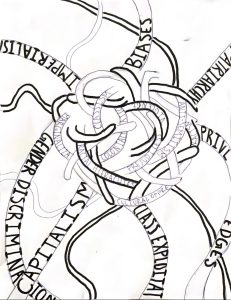Leveling-Up Must Happen Before Freshman Year
February 26, 2018
The achievement gap has been of particular concern to Cambridge Public Schools for many years, and underrepresentation of students of color in Honors (HN) and Advanced Placement (AP) courses has persisted. Such issues are present across the board, but this separation has only seemed to worsen in subjects focused on the humanities.
In history and English courses especially, distinctions between HN and College Preparatory (CP) classes seem to serve more as barriers within the student body than as separate course tracks with varying workloads.
2017 marked the first year that English courses at CRLS were “leveled up” by removing CP English classes altogether, and incoming freshmen were automatically placed in full-year HN English classes.
But the root of the debate lies not directly with the achievement gap, but with the CP and HN classes themselves. The achievement gap is a very real issue, and many, including former Mayor E. Denise Simmons, have called CP courses “colored persons” classes.
While this separation does indeed stratify students, it remains far more important to examine why students are “tracked” in the first place.

Amidst this restructuring, are the new courses maintaining the workload of the old? At least in a February meeting with the School Committee, many staff members seemed convinced.
But the fact that the courses are now a year long can distort the rigor, as HN material is now stretched to fit an adjusted schedule. And in the same meeting, staff failed to provide any examples of how leveled-up HN compared to traditional HN English, including levels of reading and writing.
In many cases, those who enroll in CP classes in 9th grade find themselves on a similar trajectory throughout their high school years.
But, CRLS’ solution, combining all incoming students into one “compromise” class, is not the correct approach.
For some, CP courses are the appropriate choice; some students cannot handle the rigor of HN classes upon arrival to the high school, and CP classes provide an alternative.
If anything, these differences are even more stark when all course levels are combined. Much of the school’s control over student ability is out of their hands; the English department cannot decide the reading and writing level of incoming freshmen, nor can they place all students together and expect equal success.
The fact that boundaries have been moved does not make the two bodies equal.
The removal of the achievement gap is crucial to student success, but the gap between HN and CP English hasn’t disappeared merely because the two options no longer exist; the fact that boundaries have been removed does not make the two bodies equal.
As important as it is to the success of all that the achievement gap be closed, this transformation must begin far sooner than freshman year of high school.
For example, greater emphasis should be placed on reading and writing education in lower grades—both in attempts to maintain the interest of above-level students and encourage growth of those who continue to struggle.
If anything, Cambridge elementary schools must take an approach similar to the high school.
Solutions must be instituted at a low enough level that students arriving at CRLS are already on-level and prepared to take HN English and history; leveling up is one step in the right direction, but it must be supplemented at an earlier stage so that the achievement gap becomes a thing of the past, not a can we continue to kick farther down the road.
This piece also appears in our February print edition.










